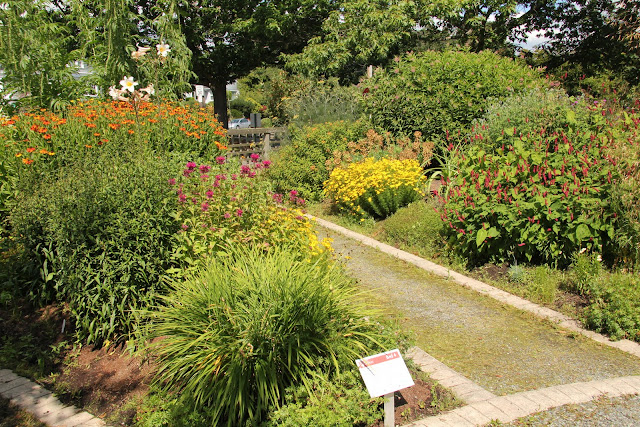In my last post, I showcased some of the private gardens I visited while attending the 2011 Garden Bloggers Fling in Seattle, WA. A nice contrast to these was some of the great public gardens, arboretums and parks in the Seattle area. Here are some of the highlights I enjoyed:
Dunn Gardens
Dunn Gardens is a beautiful spot and currently listed on the National Register of Historic Places. Located in Seattle's Broadview neighborhood, it was once the summer home of Arthur Dunn and was originally landscaped by the Olmsted Brothers in 1915.
The Olmsted firm, established in 1858 by Frederick Law Olmsted
(1822-1903), designed some of the most notable urban parks in the United
States, including Central Park in New York City, the capitol grounds in
Washington D.C., and Boston Commons.
The Olmsted Brothers liked to work with the natural topography of the site in their designs, and tried to incorporate as much of the
native vegetation and surrounding landscape as possible. A characteristic Olmsted plan included wide,
curving paths that connected a series of individual park-like settings, each
reflecting the characteristics of its individual site. The parks often
featured broad lawns, punctuated by stands of native trees and shrubs.
Dunn Gardens is the only Olmsted residential garden regularly open to the public
in Washington state.
The weeping beech tree looks like a natural waterfall into the pond below.
Ferns growing above a moss-covered bed.
Beautiful mix of plants all within the same color scheme.
I love the texture combinations of these plants in the above and below photos.
Some beautiful plants in the curator's garden.
Miller Library and Gardens
Housed at the University of Washington's Center for Urban Horticulture, the Miller Library
is the first and only library in the Seattle area dedicated to gardening and
horticulture. Gardeners, horticulturists and naturalists could all find something of interest here, and better yet, they would be able to borrow from the collection like a regular library.
The library has over 15,000 books and more than 700 garden periodicals. There's even a rare-book
collection with garden texts dating back to the
17th century.
Outside the libary, are UW Botanic Gardens. Officially referred to as the Soest Herbaceous Display Gardens, it was
created to help local gardeners select plants appropriate to a variety
of site conditions commonly found in Pacific Northwest urban gardens.
This garden features over 280 kinds of herbaceous plants
that include perennials, annuals, and bulbs.
The gardens demonstrate how soil and light affect plant
growth and health; each of the eight beds have a different mixture of soil type and light exposure.
Bellvue Botanical Gardens
The sun shone brightly on this 36 acre botanical garden which is filled with perennial borders, alpine gardens, dahlia and fuschia gardens, woodlands and meadows - just to name a few.
 |
| Perennial gardens |
 |
| I call this a "fuzzy daisy" |
After spending a long day in the sun, the woodland gardens were a welcome retreat for me. The winding path was filled with trees, ferns and silent greenery.
 |
| Is this the door to a Hobbit's home?? |
Olympic Sculpture Park
This 9 acre park is a great way to experience different types of sculpture in an outdoor setting, all while enjoying the incredible views of Puget Sound and the Olympic Mountains.
 |
| Colorful wildflowers grew along the path in the park. |
Naturally, our group of garden enthusiasts were most excited and intrigued by the Nekoum Vivarium (vivarium means "a place of life" in Latin). In 2006, artist Mark Dion had a vision for a vivarium and, with permission from the State, had a Western Hemlock tree moved from Green River Watershed to a special greenhouse at the Olympic Sculpture Park.
Dion has been quoted as describing the vivarium as:
"In some ways, this
project is an abomination. We’re taking a tree that is an ecosystem—a
dead tree, but a living system—and we are re-contextualizing it and
taking it to another site. We’re putting it in a sort of Sleeping Beauty
coffin, a greenhouse we’re building around it. And we’re pumping it up
with a life support system — an incredibly complex system of air,
humidity, water, and soil enhancement — to keep it going. All those
things are substituting what nature does—emphasizing how, once that’s
gone, it’s incredibly difficult, expensive, and technological to
approximate that system—to take this tree and to build the next
generation of forests on it. So this piece is in some way perverse. It
shows that, despite all of our technology and money, when we destroy a
natural system it’s virtually impossible to get it back. In a sense
we’re building a failure."
(http://atlasobscura.com/place/neukom-vivarium-olympic-sculpture-park)
Seattle Arboretum at South Seattle Community College
The South Seattle Community College Arboretum was established by the
College and the SSCC Foundation in 1978 in part
as the result of a petition by the Landscape Horticulture Program
students for an arboretum to serve as their living laboratory.
The 6-acre site is used as a laboratory for plant
identification, arboriculture, irrigation, landscape maintenance and landscape
construction courses. The Arboretum is also used as an outdoor classroom
by professional horticulturists and hobby gardeners.
The final public garden we visited was the Bloedel Reserve on Bainbridge Island. It was such an incredible place and I have so many photos to share. It truly deserves its own post, so stay tuned!


















No comments:
Post a Comment
Note: Only a member of this blog may post a comment.